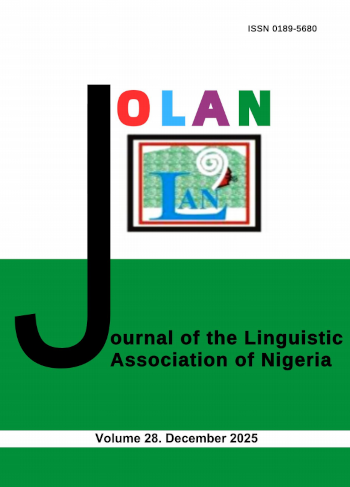Intertexuality in President Obasanjo’s “Before It Is Too Late”
Keywords:
intertextuality, ideology, social structure, CDAAbstract
A letter is commonplace written communication which takes different forms depending on its social context. The context includes various societal currents that are responsible for the production, consumption and interpretation of such letter. Hence, a letter is semantic unit which incorporates the writer’s perceptions of an event which may be clearly stated or obfuscated. It is upon this platform that this study interrogates the intertextual strategies exploited by former President Obasanjo to present his view to former President Jonathan in his letter of appeal. The paper uses a theoretical framework of Critical Discourse Analysis (CDA) to reveal the ways in which linguistic structure and communicative devices overtly or covertly harbour ideological meaning. President Obasanjo adopts intertextual strategies to bring a memory of past events into President Jonathan’s mind. This is because recreating knowledge of the past in texts tends to give hearers or readers a fairly clear understanding of the current situation.The paper therefore concludes that it is impossible not to have intertextual reference in any expression longer than a sentence.
References
Bakhtin, M.M. (1986). The problem with speech genres in In C. Emerson and M. Holquist (eds) speeh genres and other Essays : M.M. Bakhtin (trans.V. macGee). Austin : university of Texas, Press, pp 60-102
Beaugrande, R . de and Dressler, W. (1981). Introduction to Text Linguistics, London: Longman
Bloor, M. & Bloor, T. (2007). The Practice of Critical Discourse Analysis, an Introduction, London: Hodder Education.
Cresswell, J. W. (2008). Resource Design: Qualitative, Quantitative and Mixed Approaches. London: SAGE Publication.
Fairclough N. (1995). Critical Discourse Analysis. London: Longman.
Fairclough, N. (1992). Discourse and Social Change, Cambridge, Polity Press.
Fairclough, N. (1993). Critical Discourse Analysis and the Marketisation of Public Discourse: The University, Discourse and Society, 4:133-168
Huckin, T. (1995). Critical Discourse Analysis. The Journal of TESOL 2(3): 95-112.
Huckin, T. (2002). Textual silence and the discourse of homelessness. Discourse and Society 13(3): 347-72.
Jorgenson, M.N. and Philip, J.L. (2002). Discourse Analysis and Method, London: SAGE Publication.
Johnstone B. (2008). Discourse Analysis 2nd Edition Oxford: Blackwell publishing.
Pasha, T. (2011). Islamists in the Headlines: Critical Discourse Analysis of the Presentation of the Muslim Brotherhood in the Egyptian Newspapers. Unpublished PhD Dissertation. University of Utah.
Scollon, R. (1998). Interdiscursivity and Identity. In: Tooland, M. (ed.) Critical Discourse Analysis, Critical Concepts in Linguistics. Vol. iv. London and New York: Routledge. Pp. 79-94
Tuchman, G. (1972). Objectivity as strategic ritual. American Journal of Sociology 77: 66-80.
van Dijk, T.A (1998). Critical Discourse Analysis (online material)
van Dijk, T.A (1998b). Opinions and Ideologies in Press. In A. Bell and P.Garrett (eds.), Approaches to Media Discourse.Oxford: Blackwell.pp. 21- 63.
Wallace, C. (1992). Reading. Oxford: University Press.
White,P.R.(2003)Engagement:Intertextuality. http://www.grammatics.com/appraisal/index.html.Accessed 2007
Yule,G. (1996). The Study of Language. Cambridge University Press.














